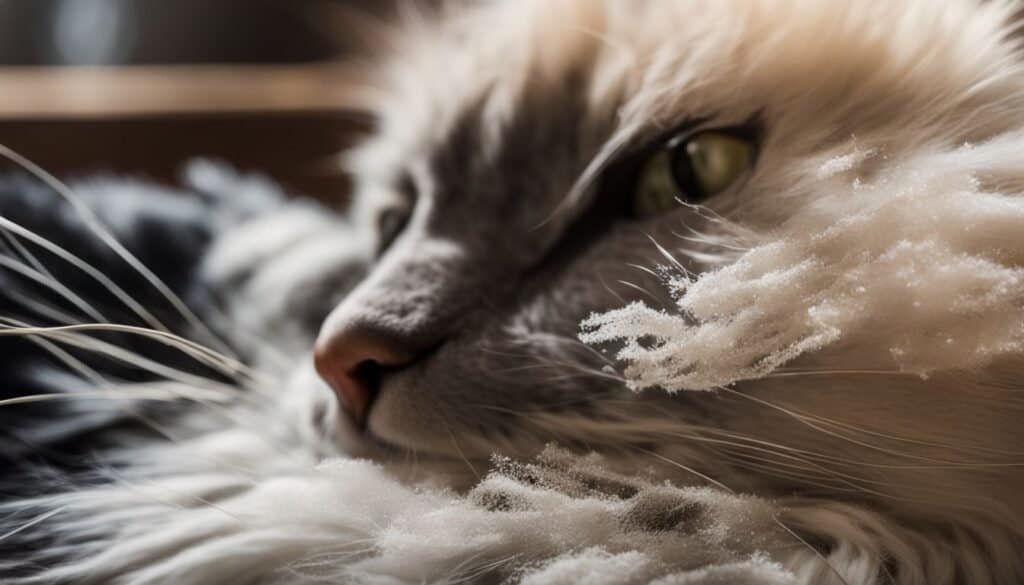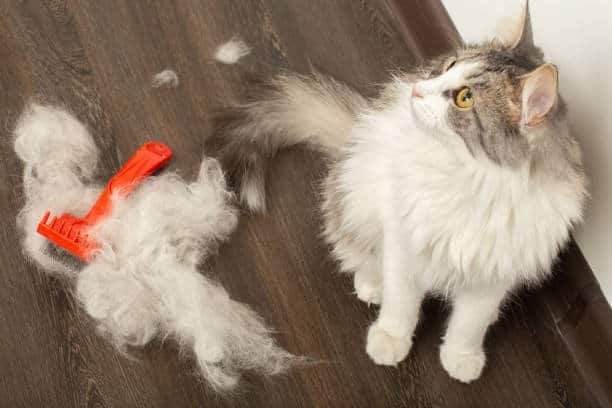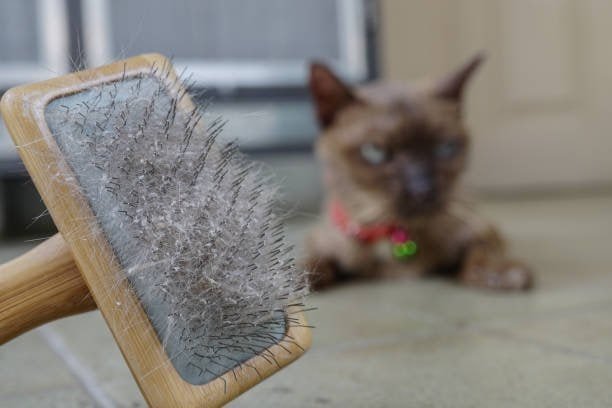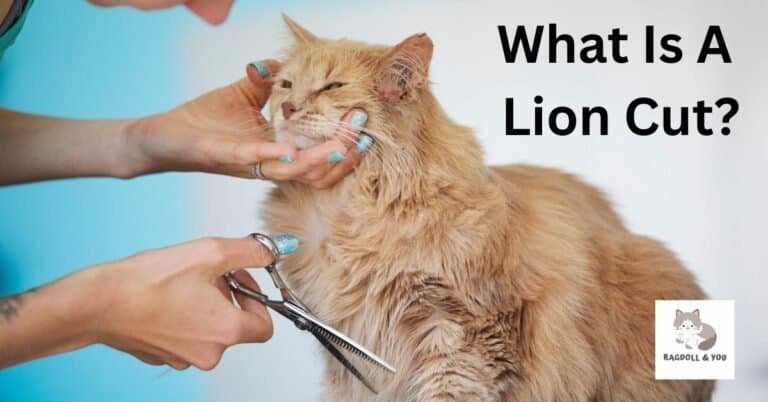What Is Cat Dandruff? Causes, Solutions, Treatment & More
Cat dandruff refers to small, white flakes on a cat’s fur from shed skin cells. Typically invisible, large amounts of dandruff can accumulate, causing skin dryness and itchiness. Dandruff often links to nutritional deficiencies, especially omega-3 fatty acids, in cat food.
Other potential causes include external parasites like fleas or underlying illnesses. While minor dandruff is normal shedding, excess flakes signify an issue requiring attention to alleviate discomfort and treat the root problem. Monitoring dandruff helps ensure your cat’s health and wellbeing.
Why Does My Cat Have Dandruff?
There are several reasons why your cat may have dandruff. It includes dehydration, health issues, lack of fatty acids in their daily diet, grooming issues, and certain bathing products.
Dehydration
Cats need plenty of water to stay healthy. Not enough water consumption makes a cat’s skin dry. Dry skin forms dandruff in cats. Your pet needs to drink lots of fluids. A hot and dry environment causes cats to lose body fluids and quickly dehydrate. It makes their skin dry and flake off as dandruff.
Ensure your cat always has plenty of clean drinking water, especially in the heat. Fill their water bowl from time to time.
Health Issues
Some cat breeds get dandruff because of health problems. One sick cat may not clean its fur well. This can lead to dry hair, skin, and dandruff. In other cases, a cat’s body might make too much oil. The extra oil can mix with dead skin cells and form dandruff.
Diseases can also cause cat dandruff. High blood sugar in cats causes thick, oily skin that flakes off easily. Pets with discomfort from arthritis or old might find grooming practices hard and get larger flakes on their fur.
Other illnesses like heart or Polycystic kidney disease change how your pet’s entire body works. These changes often dry the skin, leading to flaky patches or dandruff.
Cancer is another major health concern linked to cat dandruff. Some types of cancer affect the skin directly, which could increase flaky patches on your kitty’s hair coat.

Lack of Fatty Acids in Diet
Cats needs quality food and balanced nutrition to stay healthy. Some food lacks the all-important omega-3 fatty acids and omega-6 fatty acids. Cats not eating enough of these fatty acids may get dandruff. This is because their skin gets dry and flaky.
Omega fatty acids keep a cat’s skin strong and shiny. Ensure your cat eats quality food, like wet cat food!
Grooming Issues
Regular grooming prevents dandruff in cats. Cats may develop dandruff if they cannot groom themselves properly due to obesity or mobility issues.
When cats cannot reach certain body parts, like their back, it can lead to the buildup of dirt and oils. This contributes to dandruff.
Matted hair and tangles in a cat’s fur can create an environment where dandruff thrives. A cat owner must groom by brushing their cats regularly and removing mats or tangles promptly. Be moderate, as excessive grooming can turn skin dry.
Bathing Products
Using bathing products can effectively treat cat dandruff. These products can address underlying causes and reduce dandruff. Appropriate grooming products during bathing can alleviate skin scrapings and promote a healthier hair coat.
Choose the right bathing products for your cat’s needs and follow instructions carefully. Using these bathing products, you can identify and treat specific parasites too. Bathing products can effectively treat primary and secondary seborrhea dermatitis, characterized by dry, flaky cat skin.

How Do You Treat Dandruff in Cats?
To treat dandruff in cats, you can provide a proper diet, regular grooming, special shampoo, and maintain a healthy weight. Ensure adequate hydration and use a humidifier if needed.
Proper Diet
A proper diet is essential for managing cat dandruff. A well-balanced diet with omega-3 fatty acid supplements can improve a cat’s skin and reduce dandruff. Foods rich in animal nutrition and fatty acids from fish oil or flaxseed are good options for your cat’s meals.
Avoiding food allergies or sensitivities is also important. Provide your cat with a nutritious diet to reduce dandruff and promote overall health.
Grooming
Regular grooming is an effective way to treat specks of dandruff. Introducing bathing and regular grooming sessions can alleviate dandruff in your cat. Regularly brushing or combing your cat’s fur will also remove dust, pollen, and dead skin cells. A professional groomer can sometimes help alleviate allergy symptoms by removing allergens from your cat’s fur.
Special Shampoo
Specialized dandruff waterless shampoos designed for cats can be a helpful solution. These cat dandruff shampoos are formulated to reduce flaking and moisturize the skin, relieving your furry friend.

These anti-dandruff shampoos contain natural ingredients like oatmeal extracts, horsetail, wood, lavender, lemongrass, or apple cider vinegar. Pet MD Benzoyl Peroxide Medicated Shampoo and Burt’s Bees for Cats Hypoallergenic Shampoo are popular.
Healthy Weight
Maintaining a healthy weight in cats prevents dandruff. Obesity can limit a cat’s ability to groom itself properly, leading to dry skin and dandruff.
When cats are overweight, reaching certain body parts or skin during grooming becomes difficult, causing build-up. Helping your cat maintain a healthy weight through proper diet and exercise can reduce the risk of dandruff.
Hydration
When cats are dehydrated, they can develop dry skin and dandruff. To prevent this, ensure your cat has access to water.
Adding more moisture to their quality diets can also be beneficial in reducing dandruff. Consider feeding them wet food or adding clean water to their kibble. Adjusting an arid environment using a humidifier may also alleviate the symptoms of dandruff.
Humidifier
Adding a humidifier or air purifier to your home can reduce cat dandruff. Especially during dry winter, using a humidifier add moisture to the air and prevents your cat’s skin from drying. It helps shield from several seasonal allergies too.
The proper moisture level in the air keeps your cat’s skin hydrated and reduces the chances of dandruff. You can maintain an optimal moisture balance with a humidifier in the rooms where your cat spends the most time.
Symptoms of Cat Dandruff
A few additional symptoms can accompany Cat dandruff. They are heat, bugs, environmental allergens, food allergies, obesity, malnutrition, skin infections, heart disease, kidney disease, arthritis/old age, hyperthyroidism, and autoimmune skin conditions.

Heat
Low humidity and indoor heating systems can contribute to dandruff. When the air in your home is dry, it can cause your cat’s skin to dry, leading to dandruff.
Indoor heating systems lead to loss of skin moisture, which can worsen this problem. You can use a humidifier in your home to help prevent and treat cat dandruff caused by heat.
Bugs
Bugs like fleas, ticks, and mite species can cause dandruff and flaky skin in cats. These tiny parasites infest your cat’s fur and cause itching, skin irritation, and the production of excess dead skin cells.
Cheyletiella mites can cause Cheyletiellosis or “walking dandruff,” which is highly contagious among cats. Mange, another skin condition caused by parasitic mites, can also result in dandruff. Other symptoms include hair loss and inflammation.
External parasites like fleas and ticks can trigger cat allergies that might manifest as dandruff. Regularly check for these bugs on your cat, as their presence may indicate an infestation.
Environmental Allergens
Allergens, like pollen, mold spores, and dust mites, can cause cat dandruff. Environmental allergies can irritate your cat’s skin, leading to skin dryness and flaking. They are more susceptible if your cat spends much time outdoors or in dusty environments.
Keep your home clean and dust and mold free to minimize the impact of environmental allergens on your cat’s skin health.
Food Allergies
Food allergies are a common cause of dandruff in cats. Certain foods, like beef, fish, chicken, and dairy products, can trigger cat allergic reactions. Cats must be exposed to a specific food ingredient before developing an adverse reaction. These allergic diseases can lead to skin problems like dandruff and cat inflammation if left undiagnosed.
Obesity
Obesity can develop dandruff in cats. Cats may experience dry and flaky skin when overweight, especially in the base of their tail or lower back.
This is because obesity can make grooming difficult for them. Cats with a bit of weight are more prone to developing severe dandruff than healthy ones.
Malnutrition
Malnutrition is a condition where cats don’t get enough nutrients. This can cause their skin to become dry and flaky. Cats need a balanced diet with all the vitamins and minerals for healthy skin and fur.
If a cat is malnourished, it may have scruffy or patchy types of coats, a sign of dandruff.
Skin Infections
Fungal or Bacterial infections can lead to flaky and itchy skin in cats. These infections can result in red, inflamed skin prone to further complications.
One example is Cheyletiellosis, caused by Cheyletiella mites. These mites are highly contagious and can infect both cats and dogs.

Heart Disease
Heart disease is a serious condition affecting cats, including those with dandruff. Some cases of adult-onset heart disease in cats can be due to a hereditary condition.
Uncontrolled diabetes and other metabolic diseases can also result in feline dandruff. Regular check-ups and proper management of existing medical conditions are essential.
Kidney Disease
Kidney disease is a serious health condition that affects cats. It can cause poor inner and outer coat health, including dandruff, thinning hair follicles, and patchy loose hair. If your cat’s fur looks dull and has dandruff, it could be a sign of kidney disease.
Dehydration also contributes to these symptoms. Kidney failure in cats leads to excessive thirst and urination, which impact their outermost layer and cause dandruff.
Arthritis/Old Age
Cats with arthritis may have difficulty grooming themselves properly, leading to dry or oily flakes buildup on their skin. Older cats may experience changes in their skin and coat, making dandruff more visible, particularly in dark-furred cats. Look for arthritis management options for a change.
Hyperthyroidism
Hyperthyroidism is a condition that can affect cats, and an overactive thyroid gland characterizes it. This can cause various cat symptoms, including weight loss, increased appetite, thirst, and urination.
Cats with hormonal imbalances may have dull fur with dandruff and exhibit signs of cat dandruff like dryness or itchiness. Hyperthyroidism can sometimes make cats more energetic and active than usual.
Autoimmune Skin Conditions
Autoimmune skin conditions are rare in cats but can be associated with symptoms of cat dandruff. Among many autoimmune skin disorders is discoid lupus erythematosus.
This condition causes loss of pigmentation around the nose and excessive scratching, licking, or chewing of the fur. If you notice these signs of cat dandruff, opt for veterinary medicine for proper diagnosis and treatment.
Cancer
Cancer is a serious condition that can cause dandruff in cats. Different types of cancer can lead to this problem, like cutaneous lymphoma and feline paraneoplastic alopecia.
A cat with cancer weakens their immune system, making them more vulnerable to skin conditions like dandruff.
Natural Home Remedies for Cat Dandruff
If your cat has dandruff, try these topical treatments and natural home remedies to alleviate the problem:
- Adding olive oil to your cat’s food can moisturize its skin and reduce dandruff.
- A moisturizing shampoo with oatmeal and aloe vera can soothe and hydrate their skin, relieving dandruff or white speck.
- Ensure your cat stays hydrated by providing clean water at all times. It can improve their skin health and reduce dandruff.
- Regular grooming, like brushing your cat’s fur, stimulates oil production in the skin. It distributes it evenly, preventing dryness and larger flakes.
- Using a humidifier in your home can increase the moisture levels in the air, which can benefit your cat’s skin.

Cat Dandruff vs. Flea Eggs
| Cat Dandruff | Flea Eggs |
| Cat dandruff is caused by dry skin and appears as gray or white flecks. | Flea eggs are tiny and oval-shaped. |
| Cat dandruff is not contagious and does not spread from one cat to another. | Flea eggs can be transferred from infested cats to other animals. Reaction in humans can also be seen due to flea dirt. |
| Dandruff is a common condition that can be treated with proper diet and grooming. | Flea dirt indicates an infestation and requires immediate flea control medication or treatment. |
| Cat dandruff is visible throughout the cat’s greasy coat. | Allergies to fleas are usually concentrated in necks, tails, etc. |
| Cat dandruff does not always impose a serious risk and shows speedy recovery. | Flea eggs are a sign of flea infestation. |

How Vets Diagnose Dandruff in Cats
Vets diagnose dandruff in cats by examining their skin and loss of fur. They also perform tests to identify any underlying condition causing the dandruff.
- Physical Examination: Vets will closely examine the cat’s skin and coat for signs of dandruff, like flaking or dryness.
- Medical History: Vets will ask the pet owner about changes in the cat’s behavior, diet, or other symptoms.
- Skin Scraping: Vets may take a small sample of the cat’s skin to check for parasitic infections or others under a microscope.
- Blood Tests: Vets may recommend blood tests to check for any underlying health conditions contributing to the dandruff.
- Allergy Testing: If skin allergies are suspected of causing dandruff, vets may perform allergy testing to identify specific allergic responses.

Best FAQ
Can Dandruff Be A Symptom Of An Underlying Health Problem?
Dandruff can sometimes be a sign of a more pressing health issue. Poor diet, dehydration, and yeast infections contribute to cat dandruff. Changes in the environment and primary seborrhea dermatitis also lead to dandruff in cats.
How Can I Prevent Cat Dandruff?
To prevent cat dandruff, ensure your cat gets enough moisture, especially during dry winters. A humidifier adds moisture to the air and keeps their skin hydrated.
Second, give them infrequent baths using a suitable shampoo. Regular grooming is also important. Brushing your cat’s fur removes any dead skin cell and distributes natural oils throughout its coat, preventing dandruff.
Can I Use Human Dandruff Shampoos On My Cat?
Using human dandruff shampoos or laundry soap on your cat is not recommended. Human shampoos have different pH levels than those designed for cats, which can cause dryness and irritated skin.
Use cat shampoos specifically formulated for dry skin and cat dandruff. These products will be gentle on your cat’s skin and alleviate its dandruff without causing any pet harm.
Is Cat Dandruff Common In Older Cats?
Dandruff is more common in older cats. As cats age, they may have difficulty grooming themselves properly, leading to increased dandruff. Older cats may be more prone to dry and flaky skin, contributing to dandruff.
Should I Be Concerned If My Cat Has Occasional Dandruff?
If your cat has occasional dandruff, there is no need to worry too much. It is quite common and usually not a big problem. If your cat’s dandruff becomes significant or happens often, it might indicate an underlying issue.
Skin problems like excessive dandruff can indicate something more serious with your cat’s health. Consult a veterinarian if you notice persistent or severe dandruff in your cat.
Should I Wash My Cat If It Has Dandruff?
If your cat has dandruff, you may wonder if washing them will help. Overbathing can make dandruff worse. Focus on other methods like regular brushing to remove loose flakes and stimulate oil production in their skin.
Addressing the underlying cause of dandruff is also crucial for effective cat dandruff treatments. Consulting with a veterinarian will determine the best action for your cat’s needs.
What Stops Cat Dandruff?
To stop cat dandruff, address the underlying causes. Start by ensuring your cat has a proper diet with fatty acids to keep its skin healthy. Regular grooming removes dead skin cells and distributes natural skin oils.
Use special shampoos designed for cats with dandruff. Keeping your cat at a healthy pound of body weight and providing enough hydration is also crucial. Treating the cause of dandruff is key to preventing it from returning.
Is Dandruff Painful For Cats?
Dandruff itself is not painful for cats. If left untreated, it can lead to more serious skin problems that may cause discomfort or pain. Cat dandruff can be accompanied by red, irritated patches of skin and thick, scaly skin.
Does Cat Dandruff Spread?
Cat dandruff can spread from one pet to another in the house. One of the causes of cat dandruff is Cheyletiella mites, which can affect cats, dogs, and rabbits. If one pet has these mites and sheds dandruff, other pets may become infected too.
Can I Put Coconut Oil On My Cat?
Coconut oil can be beneficial for cats and may help with cat dandruff. Before using it, consult your vet to ensure it suits your cat. Applying coconut oil directly on your cat’s skin can moisturize their skin and reduce dandruff.
Topical applications like coconut oil contain medium-chain fatty acids that promote healthy skin in cats. Although not toxic, coconut oil may not suit all cats, so check with your vet before using it.
Can I Put Oil On My Cat For Dandruff?
You can put oil on your cat to help with dandruff. Certain oils, like olive or coconut oil, can moisturize your cat’s skin and reduce flakiness. Use only a small amount of oil and ensure it is safe for cats.
Avoid using essential oils or any products that may be toxic to cats. Always consult your veterinarian before trying home remedies for dandruff in cats.
Is Cat Dandruff Fungal?
A bacterial and fungal skin infection can cause cat dandruff. Fungal infections like ringworm are one possible cause of dandruff. These infections can lead to flaky and dry cat skin, resulting in dandruff.
If your cat is experiencing dandruff, consider the possibility of a fungal infection and seek medical treatment.
What Food Reduces Cat Dandruff?
Feeding your cat the right food can reduce dandruff. Adding ample water to their diet is a simple solution that can make a big difference. Look for wet or dry cat food high in additional omega-3 fatty acids.
A poor diet lacking essential nutrients contributes to dry and itchy skin in cats. Consider switching to Smalls Human-Grade Fresh Turkey or other bird options recommended for reducing shedding and dandruff in cats.
Why Does My Cat Have Dandruff On His Back?
A few different reasons can cause cat dandruff on the back. One possible cause is dehydration, leading to dry and flaky skin. Skin issues like bacterial or fungal infections and oily seborrhea dermatitis may contribute to dandruff on your cat’s back.
What Parasite Causes Cat Dandruff?
One parasite that can cause dandruff is called Cheyletiella mites. These highly contagious mites can lead to Cheyletiellosis or “walking dandruff.” It gets this name because the mites look like tiny pieces of dandruff moving on the cat’s skin.
Other parasites, like ticks and demodectic mange mites, can also contribute to feline dandruff. Treating these parasites promptly helps alleviate your cat’s dandruff problem.







